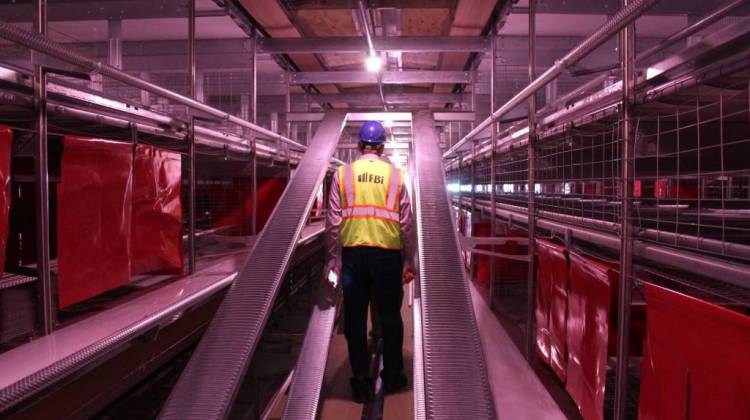
An Indiana Farm Bureau official tours an unfinished large-scale cage-free egg facility at Rose Acre Farms in Pulaski County. Each block of the house will contain 1,100 chickens, which can move freely across their aisle, up and down ramps and through different nesting areas.
Annie Ropeik/IPBEgg producers are scrambling to keep up with rising corporate demand for cage-free eggs. For Indiana-based Rose Acre Farms, the nation’s second-biggest egg producer, that means building three huge, new, high-efficiency cage-free houses in Pulaski County – capable of churning out a million eggs a day.
Going cage-free is not as simple as setting chickens loose, or taking cages out of a conventional chicken house. It can cost up to $50 a bird, and construction can take months. Rose Acre is working with another big Indiana company, Summit Livestock Buildings, to build its new cage-free facilities. They’re essentially four-story-high egg factories, costing about $10 million apiece.
Summit engineer Josh Schoon shows off the fabric conveyor belt below a slanted metal mesh floor, where the Rose Acre chickens will lay their eggs. This house is still under construction, but most of the inside is finished.
“There’s about a two-inch gap for the eggs to roll in, and they roll into the conveyor and they’re transported to the front of the house,” Schoon says.
From there, the conveyor moves the eggs to a grading facility next door. The new chicken houses are separated into blocks that hold 1,100 chickens each, with nesting areas curtained off by red plastic and places to perch, scratch, run and fly. Each entire house holds 378,000 birds – more than three times the size of Rose Acres’ current caged facilities in Pulaski County.
Consumers still pay a premium for cage-free eggs. That’s due not just to these construction costs, but also to problems with chickens fighting and laying eggs where they shouldn’t, and the need for more food to offset the calories birds can burn in their extra space. And consumer demand for these higher-priced eggs is actually lagging. But Indiana State Poultry Association Executive vice president Paul Brennan says fast food and grocery chains, such as McDonald’s and Walmart, still aim to make cage-free the new standard by 2025.
“We’re either in or we’re out,” he says. “If our customer, the big companies, are telling us they want this, they’ve got to have it.”
Rose Acre’s first cage-free building in Pulaski County starts operating next month. The company employs 600 people in Indiana, out of 2,200 across seven states. Indiana is the second biggest egg-producing state in the country.
 DONATE
DONATE








 Support WFYI. We can't do it without you.
Support WFYI. We can't do it without you.